[English] 日本語
 Yorodumi
Yorodumi- PDB-7jgs: Structure of Drosophila ORC bound to poly(dA/dT) DNA and Cdc6 (co... -
+ Open data
Open data
- Basic information
Basic information
| Entry | Database: PDB / ID: 7jgs | ||||||
|---|---|---|---|---|---|---|---|
| Title | Structure of Drosophila ORC bound to poly(dA/dT) DNA and Cdc6 (conformation 2) | ||||||
 Components Components |
| ||||||
 Keywords Keywords | REPLICATION / origin recognition complex / DNA replication initiation / DNA binding | ||||||
| Function / homology |  Function and homology information Function and homology informationalpha-heterochromatin / larval feeding behavior / CDC6 association with the ORC:origin complex / septin cytoskeleton / CDK-mediated phosphorylation and removal of Cdc6 / septin cytoskeleton organization / Activation of ATR in response to replication stress / Activation of the pre-replicative complex / eggshell chorion gene amplification / Orc1 removal from chromatin ...alpha-heterochromatin / larval feeding behavior / CDC6 association with the ORC:origin complex / septin cytoskeleton / CDK-mediated phosphorylation and removal of Cdc6 / septin cytoskeleton organization / Activation of ATR in response to replication stress / Activation of the pre-replicative complex / eggshell chorion gene amplification / Orc1 removal from chromatin / DNA amplification / positive regulation of border follicle cell migration / origin recognition complex / Assembly of the ORC complex at the origin of replication / nuclear origin of replication recognition complex / olfactory learning / nuclear pre-replicative complex / DNA replication preinitiation complex / mitotic chromosome condensation / mitotic DNA replication checkpoint signaling / chromosome condensation / DNA replication origin binding / DNA replication initiation / nuclear pore / ribonucleoprotein complex binding / heterochromatin / GTPase activator activity / mitotic spindle organization / learning / DNA-templated DNA replication / mitotic cell cycle / learning or memory / DNA replication / cell division / chromatin binding / protein homodimerization activity / ATP hydrolysis activity / DNA binding / ATP binding / metal ion binding / nucleus / plasma membrane Similarity search - Function | ||||||
| Biological species |  synthetic construct (others) | ||||||
| Method | ELECTRON MICROSCOPY / single particle reconstruction / cryo EM / Resolution: 3.2 Å | ||||||
 Authors Authors | Schmidt, J.M. / Bleichert, F. | ||||||
| Funding support |  Switzerland, 1items Switzerland, 1items
| ||||||
 Citation Citation |  Journal: Nat Commun / Year: 2020 Journal: Nat Commun / Year: 2020Title: Structural mechanism for replication origin binding and remodeling by a metazoan origin recognition complex and its co-loader Cdc6. Authors: Jan Marten Schmidt / Franziska Bleichert /   Abstract: Eukaryotic DNA replication initiation relies on the origin recognition complex (ORC), a DNA-binding ATPase that loads the Mcm2-7 replicative helicase onto replication origins. Here, we report cryo- ...Eukaryotic DNA replication initiation relies on the origin recognition complex (ORC), a DNA-binding ATPase that loads the Mcm2-7 replicative helicase onto replication origins. Here, we report cryo-electron microscopy (cryo-EM) structures of DNA-bound Drosophila ORC with and without the co-loader Cdc6. These structures reveal that Orc1 and Orc4 constitute the primary DNA binding site in the ORC ring and cooperate with the winged-helix domains to stabilize DNA bending. A loop region near the catalytic Walker B motif of Orc1 directly contacts DNA, allosterically coupling DNA binding to ORC's ATPase site. Correlating structural and biochemical data show that DNA sequence modulates DNA binding and remodeling by ORC, and that DNA bending promotes Mcm2-7 loading in vitro. Together, these findings explain the distinct DNA sequence-dependencies of metazoan and S. cerevisiae initiators in origin recognition and support a model in which DNA geometry and bendability contribute to Mcm2-7 loading site selection in metazoans. | ||||||
| History |
|
- Structure visualization
Structure visualization
| Movie |
 Movie viewer Movie viewer |
|---|---|
| Structure viewer | Molecule:  Molmil Molmil Jmol/JSmol Jmol/JSmol |
- Downloads & links
Downloads & links
- Download
Download
| PDBx/mmCIF format |  7jgs.cif.gz 7jgs.cif.gz | 514.5 KB | Display |  PDBx/mmCIF format PDBx/mmCIF format |
|---|---|---|---|---|
| PDB format |  pdb7jgs.ent.gz pdb7jgs.ent.gz | 397.6 KB | Display |  PDB format PDB format |
| PDBx/mmJSON format |  7jgs.json.gz 7jgs.json.gz | Tree view |  PDBx/mmJSON format PDBx/mmJSON format | |
| Others |  Other downloads Other downloads |
-Validation report
| Summary document |  7jgs_validation.pdf.gz 7jgs_validation.pdf.gz | 1.6 MB | Display |  wwPDB validaton report wwPDB validaton report |
|---|---|---|---|---|
| Full document |  7jgs_full_validation.pdf.gz 7jgs_full_validation.pdf.gz | 1.6 MB | Display | |
| Data in XML |  7jgs_validation.xml.gz 7jgs_validation.xml.gz | 78.1 KB | Display | |
| Data in CIF |  7jgs_validation.cif.gz 7jgs_validation.cif.gz | 119.4 KB | Display | |
| Arichive directory |  https://data.pdbj.org/pub/pdb/validation_reports/jg/7jgs https://data.pdbj.org/pub/pdb/validation_reports/jg/7jgs ftp://data.pdbj.org/pub/pdb/validation_reports/jg/7jgs ftp://data.pdbj.org/pub/pdb/validation_reports/jg/7jgs | HTTPS FTP |
-Related structure data
| Related structure data |  22330MC  7jgrC  7jk2C  7jk3C  7jk4C  7jk5C  7jk6C C: citing same article ( M: map data used to model this data |
|---|---|
| Similar structure data |
- Links
Links
- Assembly
Assembly
| Deposited unit | 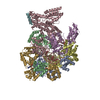
|
|---|---|
| 1 |
|
- Components
Components
-Origin recognition complex subunit ... , 5 types, 5 molecules BDEFA
| #1: Protein | Mass: 69086.445 Da / Num. of mol.: 1 Source method: isolated from a genetically manipulated source Source: (gene. exp.)   Trichoplusia ni (cabbage looper) / References: UniProt: Q24168 Trichoplusia ni (cabbage looper) / References: UniProt: Q24168 |
|---|---|
| #3: Protein | Mass: 52277.109 Da / Num. of mol.: 1 Source method: isolated from a genetically manipulated source Source: (gene. exp.)  Gene: Orc4, Dmel\CG2917, DmORC4, dmOrc4, ORC, ORC4, orc4, rDmORC, CG2917, Dmel_CG2917 Production host:  Trichoplusia ni (cabbage looper) / References: UniProt: Q9W102 Trichoplusia ni (cabbage looper) / References: UniProt: Q9W102 |
| #4: Protein | Mass: 52175.066 Da / Num. of mol.: 1 Source method: isolated from a genetically manipulated source Source: (gene. exp.)   Trichoplusia ni (cabbage looper) / References: UniProt: Q24169 Trichoplusia ni (cabbage looper) / References: UniProt: Q24169 |
| #5: Protein | Mass: 29284.129 Da / Num. of mol.: 1 Source method: isolated from a genetically manipulated source Source: (gene. exp.)   Trichoplusia ni (cabbage looper) / References: UniProt: Q9Y1B2 Trichoplusia ni (cabbage looper) / References: UniProt: Q9Y1B2 |
| #6: Protein | Mass: 54485.633 Da / Num. of mol.: 1 Source method: isolated from a genetically manipulated source Source: (gene. exp.)   Trichoplusia ni (cabbage looper) / References: UniProt: O16810 Trichoplusia ni (cabbage looper) / References: UniProt: O16810 |
-Protein , 2 types, 2 molecules CG
| #2: Protein | Mass: 82364.523 Da / Num. of mol.: 1 Source method: isolated from a genetically manipulated source Source: (gene. exp.)  Gene: Orc3, CG34315-RB, Dmel\CG4088, DmORC3, DmOrc3, l(2)49Fd, l(2)vr6, LAT, Lat, lat, lat-RA, latheo, ORC, ORC3, orc3, vr-6, vr6, CG4088, Dmel_CG4088 Production host:  Trichoplusia ni (cabbage looper) / References: UniProt: Q7K2L1 Trichoplusia ni (cabbage looper) / References: UniProt: Q7K2L1 |
|---|---|
| #7: Protein | Mass: 48049.465 Da / Num. of mol.: 1 Source method: isolated from a genetically manipulated source Source: (gene. exp.)  Gene: Cdc6, CDC6, cdc6, DmCdc6, Dmel\CG5971, CG5971, Dmel_CG5971 Production host:  Trichoplusia ni (cabbage looper) / References: UniProt: Q9VSM9 Trichoplusia ni (cabbage looper) / References: UniProt: Q9VSM9 |
-DNA chain , 2 types, 2 molecules HI
| #8: DNA chain | Mass: 18206.602 Da / Num. of mol.: 1 / Source method: obtained synthetically / Source: (synth.) synthetic construct (others) |
|---|---|
| #9: DNA chain | Mass: 18747.451 Da / Num. of mol.: 1 / Source method: obtained synthetically / Source: (synth.) synthetic construct (others) |
-Non-polymers , 2 types, 8 molecules 


| #10: Chemical | ChemComp-ATP / #11: Chemical | ChemComp-MG / |
|---|
-Details
| Has ligand of interest | N |
|---|
-Experimental details
-Experiment
| Experiment | Method: ELECTRON MICROSCOPY |
|---|---|
| EM experiment | Aggregation state: PARTICLE / 3D reconstruction method: single particle reconstruction |
- Sample preparation
Sample preparation
| Component | Name: Drosophila ORC bound to poly(dA/dT) DNA duplex and Cdc6 Type: COMPLEX / Entity ID: #1-#9 / Source: MULTIPLE SOURCES | ||||||||||||||||||||||||
|---|---|---|---|---|---|---|---|---|---|---|---|---|---|---|---|---|---|---|---|---|---|---|---|---|---|
| Molecular weight | Experimental value: NO | ||||||||||||||||||||||||
| Source (natural) | Organism:  | ||||||||||||||||||||||||
| Source (recombinant) | Organism:  Trichoplusia ni (cabbage looper) Trichoplusia ni (cabbage looper) | ||||||||||||||||||||||||
| Buffer solution | pH: 7.6 | ||||||||||||||||||||||||
| Buffer component |
| ||||||||||||||||||||||||
| Specimen | Embedding applied: NO / Shadowing applied: NO / Staining applied: NO / Vitrification applied: YES Details: Recombinantly expressed and purified Drosophila ORC and Cdc6 were mixed with DNA and the DNA-bound ternary complex purified by size exclusion chromatography. | ||||||||||||||||||||||||
| Specimen support | Grid material: GOLD / Grid mesh size: 300 divisions/in. / Grid type: UltrAuFoil R1.2/1.3 | ||||||||||||||||||||||||
| Vitrification | Instrument: FEI VITROBOT MARK IV / Cryogen name: ETHANE |
- Electron microscopy imaging
Electron microscopy imaging
| Experimental equipment |  Model: Titan Krios / Image courtesy: FEI Company |
|---|---|
| Microscopy | Model: FEI TITAN KRIOS |
| Electron gun | Electron source:  FIELD EMISSION GUN / Accelerating voltage: 300 kV / Illumination mode: FLOOD BEAM FIELD EMISSION GUN / Accelerating voltage: 300 kV / Illumination mode: FLOOD BEAM |
| Electron lens | Mode: BRIGHT FIELD |
| Image recording | Electron dose: 50 e/Å2 / Detector mode: COUNTING / Film or detector model: FEI FALCON III (4k x 4k) |
- Processing
Processing
| EM software |
| |||||||||||||||||||||
|---|---|---|---|---|---|---|---|---|---|---|---|---|---|---|---|---|---|---|---|---|---|---|
| CTF correction | Type: PHASE FLIPPING AND AMPLITUDE CORRECTION | |||||||||||||||||||||
| Symmetry | Point symmetry: C1 (asymmetric) | |||||||||||||||||||||
| 3D reconstruction | Resolution: 3.2 Å / Resolution method: FSC 0.143 CUT-OFF / Num. of particles: 81248 / Symmetry type: POINT |
 Movie
Movie Controller
Controller








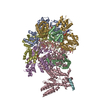
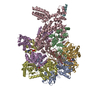
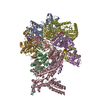
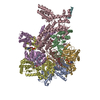
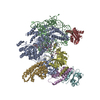
 PDBj
PDBj








































